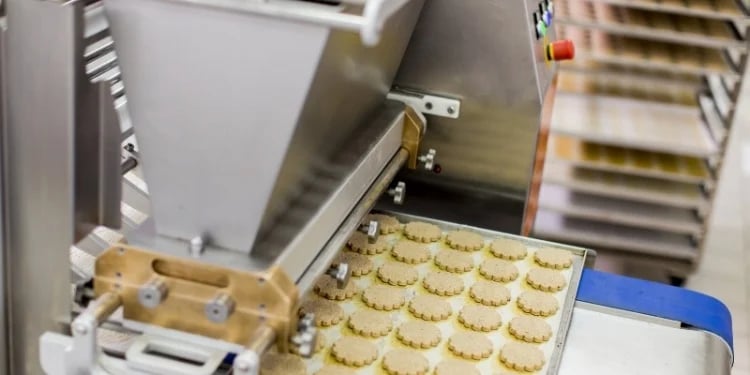Stainless steel is an optimal material for components and surfaces in food and beverage processing facilities for its durability and natural corrosion resistance. The metal is also easy to clean, which assists food processing operations in maintaining compliance with industry safety and hygiene regulations. The right approach to stainless steel surface cleaning and finishing will ultimately create a much safer and more sanitary environment while protecting product and equipment integrity.

Importance of Stainless Steel Surface Cleanliness for Sanitary Control in Food Processing
Stainless steel surfaces can become contaminated during transport, storage, fabrication, and in-production use. While contaminants can compromise virtually any operation, safety and sanitation are all the more important for steel surfaces in food and beverage processing facilities due to their potential contact with consumable goods. Anything from dirt, dust, grease, oil, rust, and iron particles to harmful bacteria can impact food quality and result in health concerns. Surface contamination can also degrade and corrode equipment over time, negatively affecting its performance and shortening its lifespan.
Stainless steel cleaning is an important preventative measure to combat these concerns. Cleaning processes improve the performance of the stainless steel by increasing its heat transfer capabilities and corrosion resistance. By removing the dirt, debris, and other surface contaminants that lessen the effectiveness of electropolishing and related finishing techniques, you help ensure high-integrity hygienic metal surfaces. Cleaning stainless steel after welding can also eliminate welding flux, spatter, or defects for a smooth look and feel.
Types of Stainless Steel Surface Cleaning & Finishing Methods
Depending on the surface material and the type of debris you wish to remove, there are multiple stainless steel weld cleaning or surface cleaning techniques available:- Mechanical. Using abrasive materials to remove surface debris, mechanical cleaning methods include grinding, particle blasting, and wire brushing. It's crucial, however, to select the right abrasive material or you risk damaging the surface of what you're cleaning.
- Chemical and electrochemical. Providing a smooth finish as part of an effective clean, chemical and electrochemical processes like polishing, acid pickling, and electrochemical dissolution can even improve corrosion resistance.
- Passivation. This process creates a protective layer of oxide film overtop the surface of stainless steel components, boosting their corrosion resistance to some degree while removing soluble contaminants and facilitating surface repair.
Stainless Steel Surface Finish: Electropolishing vs. Passivation

The faster of the two options, the electropolishing process utilizes an electric current and a temperature-controlled electrolyte bath to achieve a smooth surface. It dissolves the top layer of the stainless steel, leaving behind a nonstick surface with a shiny, clean appearance that's ideal for food and pharmaceutical applications.
If increasing corrosion resistance is the main goal, passivation is a good choice. This chemical process uses either nitric or citric acid to remove iron material from a stainless steel surface. The process then creates an oxide layer over the material that can protect against corrosion and rust without affecting the material's appearance. This has the beneficial side effect of minimizing maintenance needs. However, electropolishing offers better sanitation control as it results in smooth, defect-free surfaces that are easy to clean.
Custom Stainless Steel Products for the Food & Beverage Industry
For high-quality stainless steel goods that help you maintain a sterile manufacturing environment in food and beverage operations, Marlin Steel Wire Products LLC carries a range of customizable options to meet your needs. All of our products are 100% American-made, and we offer fast delivery for on-time solutions.
We manufacture versatile and durable baskets, racks, trays, carts, and other wire forms for the food and beverage sector using food-grade 304 or 316 stainless steel exclusively. Their high melting point and chemical resistance allow them to safely withstand harsh cleaning agents and heat-based cleansing techniques without degrading so your operation can adhere to sanitation standards.
With alterable wire spacing, our baskets drain easily and allow for maximum airflow. Also, we offer an electropolished finish on our products to prevent food byproducts or contaminants from sticking to the steel.
%20(1).jpg)
Ready to Discuss Your Food Processing Project? Contact Our Steel Wire Specialists
If you're searching for high-quality stainless steel solutions with highly cleanable surfaces for the food and beverage sector, turn to the experts at Marlin Steel. Whether you need custom or standard food processing baskets, racks, trays, displays, or other products to reliably support your operations, we'll help you make the right choice that suits your application, schedule, and budget.
For more information about our products and capabilities, contact us today.
Related Blog Posts
- What is the Best Food Grade Stainless Steel?
- Stainless Steel for Sanitation in Pharmaceutical and Food Manufacturing
- Why Electropolish Your Stainless Steel Baskets or Racks?
Client Project Examples
- Custom Wire Baskets for Large-Scale Food Processing Equipment
- Stackable Stainless Steel Baskets for Food Processing Equipment


.gif)


